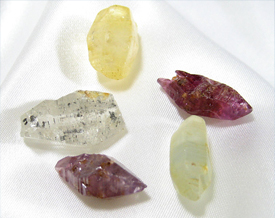About Sapphires
Sapphire Information
What is a sapphire?
Sapphires are a variety of the mineral corundum. Corundum can be found in all colors of the rainbow. The word sapphire originates from the Roman Empire word for lapis lazuli – sapphiros. Ancient Romans called green sapphire emerald, blue sapphire hyacinth and purple sapphire amethyst. Red corundum is known as ruby. One variety of sapphire, called star sapphire, has 6 and occasionally 12 rays.
The color variety of sapphire ranges from violet through blue, green, yellow, orange, pink, purple, colorless, brown, gray and black. They can be bi- or parti-colored and can show color change. Star sapphire can occur in any of the colors.
Where are sapphires found?
Important current sources include Africa (Madagascar, Kenya and Tanzania), Australia, Sri Lanka, Thailand, Burma, and Cambodia. The US has some sapphire deposits in Montana.
What significance have sapphires held in mythology?
Sapphire, the celestial gemstone, has been treasured for thousands of years. The ancient Persians believed that the earth rested on a giant blue sapphire and that its reflection colored the sky. Vatican elite traditionally wore blue sapphires in their rings and on their scepters because the blue gems were believed to represent purity of purpose and deed.
Royalty used sapphires in the belief that the stone would provide protection from harm. Blue stones were used for medicine in the Middle Ages as a treatment of eye diseases and as an antidote for poison. Eastern cultures value the phenomenal gems, especially the star varieties, as talismans for warding off evil. In the West, the star sapphire is known as the Stone of Destiny – the three lines that cross to form the star represent Faith, Hope and Charity.
How are sapphires measured?
On April 1, 1914, the carat became the standard of measurement for gems. One carat is equivalent to 200 milligrams.
Corundum

